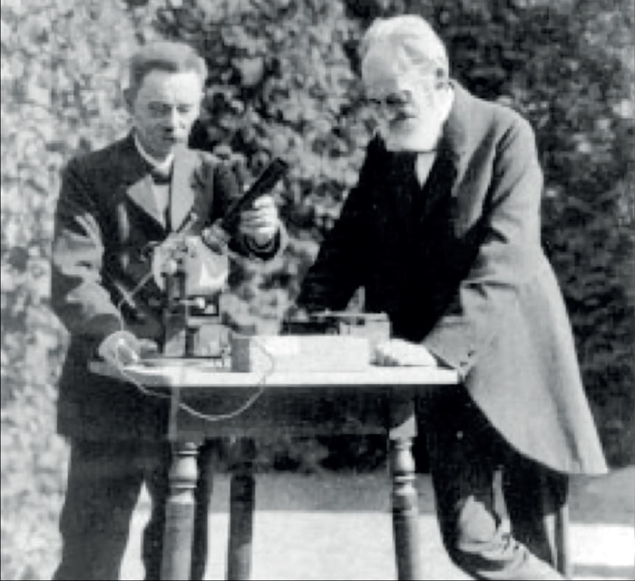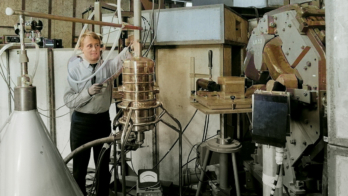A forgotten pioneer of the early days of cosmic-ray research.

In 1785 Charles-Augustin de Coulomb presented three reports on electricity and magnetism to France’s Royal Academy of Sciences. In the third of these he described his experiments showing that isolated electrified bodies can spontaneously discharge and that this phenomenon was not a result of defective insulation. After dedicated studies by Michael Faraday around 1835, William Crookes observed in 1879 that the speed of discharge decreased when the pressure was reduced: the ionization of air was thus the direct cause. But what was ionizing air? Trying to answer this question paved the way in the early 20th century towards a revolutionary scientific discovery – that of cosmic rays.
Spontaneous radioactivity had been discovered at the end of the 19th century and researchers observed that a charged electroscope promptly discharges in the presence of radioactive material. The discharge rate of an electroscope could then be used to gauge the level of radioactivity. A new era of research into discharge physics opened up, this period being strongly influenced by the discoveries of the electron and positive ions.

During the first decade of the 20th century, results on ionization phenomena came from several researchers in Europe and North America. Around 1900, Charles Wilson in Scotland and, independently two high-school teachers and good friends in Germany, Julius Elster and Hans Geitel, improved the technique for the careful insulation of electroscopes in a closed vessel, thus improving the sensitivity of the electroscope itself (figure 1). As a result, they could make measurements of the rate of spontaneous discharge. They concluded that ionizing agents were coming from outside the vessel and that part of this radioactivity was highly penetrating: it could ionize the air in an electroscope shielded by metal walls a few centimetres thick. This was confirmed in 1902 by quantitative measurements performed by Ernest Rutherford and Henry Cooke, as well as by John McLennan and F Burton, who immersed an electroscope in a tank filled with water.
The obvious questions concerned the nature of such radiation and whether it was of terrestrial or extra-terrestrial origin. The simplest hypothesis was that its origin was related to radioactive materials in the Earth’s crust, which were known to exist following the studies by Marie and Pierre Curie on natural radioactivity. A terrestrial origin was thus a commonplace assumption – an experimental proof, however, seemed difficult to achieve. In 1901, Wilson made the visionary suggestion that the origin of this ionization could be an extremely penetrating extra-terrestrial radiation. Nikola Tesla in the US even patented in 1901 a power generator based on the fact that “the Sun, as well as other sources of radiant energy, throws off minute particles of matter […which] communicate an electrical charge”. However, Wilson’s investigations in tunnels with solid rock overhead showed no reduction in ionization and so did not support an extra-terrestrial origin. The hypothesis was dropped for many years.
New heights
A review by Karl Kurz summarizes the situation in 1909. The spontaneous discharge observed was consistent with the hypothesis that background radiation did exist even in insulated environments and that this radiation had a penetrating component. There were three possible sources for the penetrating radiation: an extra-terrestrial radiation, perhaps from the Sun; radioactivity from the crust of the Earth; and radioactivity in the atmosphere. Kurz concluded from ionization measurements made in the lower part of the atmosphere that an extra-terrestrial radiation was unlikely and that (almost all of) the radiation came from radioactive material in the crust. Calculations were made of how such radiation should decrease with height but measurements were not easy to perform because the electroscope was a difficult instrument to transport and the accuracy was not sufficient.
Although a large effort to build a transportable electroscope was made by the meteorology group in Vienna (leaders in measurements of air ionization at the time), the final realization of such an instrument was made by Father Theodor Wulf (figure 2, left), a German scientist and Jesuit priest serving in the Netherlands and later in Rome. In Wulf’s electroscope, the two metal leaves were replaced by metalized silicon-glass wires, with a tension spring in between, also made of glass. The instrument could be read by a microscope (figure 2, right). To test the origin of the radiation causing the spontaneous discharge, Wulf checked the variation of radioactivity with height: in 1909 he measured the rate of ionization at the top of the Eiffel Tower in Paris (300 m above ground). Supporting the hypothesis of the terrestrial origin of most of the radiation, he expected to find less ionization at the top of the tower than at ground level. However, the rate of ionization showed too small a decrease to confirm this hypothesis. Instead, he found that the amount of radiation “at nearly 300 m [altitude] was not even half of its ground value”, while with the assumption that radiation emerges from the ground there would remain at the top of the tower “just a few per cent of the ground radiation”.

Wulf’s observations were puzzling and demanded an explanation. One possible way to solve this puzzle was to make measurements at altitudes higher than the 300 m of the Eiffel tower. Balloon experiments had been widely used for studies of atmospheric electricity for more than a century and it became evident that they might give an answer to the problem of the origin of the penetrating radiation. In a flight in 1909, Karl Bergwitz, a former pupil of Elster and Geitel, found that the ionization at 1300 m altitude had decreased to about 24% of the value on the ground. However, Bergwitz’s results were questioned because his electrometer was damaged during the flight. He later investigated electrometers on the ground and at 80 m, reporting that no significant decrease of the ionization was observed. Other measurements with similar results were obtained around the same time by Alfred Gockel, from Fribourg, Switzerland, who flew up to 3000 m (and first introduced the term “kosmische Strahlung”, or “cosmic radiation”). The general interpretation was that radioactivity was coming mostly from the Earth’s surface, although the balloon results were puzzling.
The meteorologist Franz Linke had, in fact, made 12 balloon flights in 1900–1903 during his PhD studies at Berlin University, carrying an electroscope built by Elster and Geitel to a height of 5500 m. The thesis was not published, but a published report concludes: “Were one to compare the presented values with those on ground, one must say that at 1000 m altitude […] the ionization is smaller than on the ground, between 1 and 3 km the same amount, and above it is larger … with values increasing up to a factor of 4 (at 5500 m). […] The uncertainties in the observations […] only allow the conclusion that the reason for the ionization has to be found first in the Earth.” Nobody later quoted Linke and although he had made the right measurement, he had reached the wrong conclusions.
Underwater measurements
One person to question the conclusion that radioactivity came mostly from the Earth’s crust was an Italian, Domenico Pacini. An assistant meteorologist in Rome, he made systematic studies of ionization on mountains, on the shoreline and at sea between 1906 and 1910. Pacini’s supervisor was the Austrian-born Pietro Blaserna, who had graduated in physics within the electrology group at the University of Vienna. The instruments used in Rome were state of the art and Pacini could reach a sensitivity of one third of a volt.
In 1910 he placed one electroscope on the ground and one out at sea, a few kilometres off the coast, and made simultaneous measurements. He observed a hint of a correlation and concluded that “in the hypothesis that the origin of penetrating radiations is in the soil […] it is not possible to explain the results obtained”. That same year he looked for a possible increase in radioactivity during a passage of Halley’s comet and found no effect.
Pacini later developed an experimental technique for underwater measurements and in June 1911 compared the rate of ionization at sea level and at 3 m below water, at a distance of 300 m from the shore of the Naval Academy of Livorno. He repeated the measurements in October on the Lake of Bracciano. He reported on his measurements, the results – and their interpretation – in a note entitled, “Penetrating radiation at the surface of and in water”, published in Italian in Nuovo Cimento in February 1912. In that paper, Pacini wrote: “Observations carried out on the sea during the year 1910 led me to conclude that a significant proportion of the pervasive radiation that is found in air had an origin that was independent of the direct action of active substances in the upper layers of the Earth’s surface. … [To prove this conclusion] the apparatus … was enclosed in a copper box so that it could be immersed at depth. … Observations were performed with the instrument at the surface, and with the instrument immersed in water, at a depth of 3 m”.
Pacini measured the discharge rate of the electroscope seven times over three hours. The ionization underwater was 20% lower than at the surface, consistent with absorption by water of radiation coming from outside; the significance was larger than 4 σ. He wrote: “With an absorption coefficient of 0.034 for water, it is easy to deduce from the known equation I/I0 = exp(–d/λ), where d is the thickness of the matter crossed, that, in the conditions of my experiments, the activities of the sea-bed and of the surface were both negligible. The explanation appears to be that, owing to the absorbing power of water and the minimum amount of radioactive substances in the sea, absorption of radiation coming from the outside indeed happens, when the apparatus is immersed.” Pacini concluded: “[It] appears from the results of the work described in this note that a sizable cause of ionization exists in the atmosphere, originating from penetrating radiation, independent of the direct action of radioactive substances in the crust.”
Despite Pacini’s conclusions – and the puzzling results of Wulf and Gockel on the dependence of radioactivity on altitude – physicists were reluctant to abandon the hypothesis of a terrestrial origin for the mystery penetrating radiation. The situation was resolved in 1911 an 1912 with the long series of balloon flights by Victor Hess, who established the extra-terrestrial origin of at least part of the radiation causing the observed ionization. However, it was not until 1936 that Hess was rewarded with the Nobel Prize for the discovery of cosmic radiation. By then the importance of this “natural laboratory” was clear, and he shared the prize with Carl Anderson, who had discovered the positron in cosmic radiation four years earlier. Meanwhile, Pacini had died in 1934 – his contributions mainly forgotten through a combination of historical and political circumstances.





